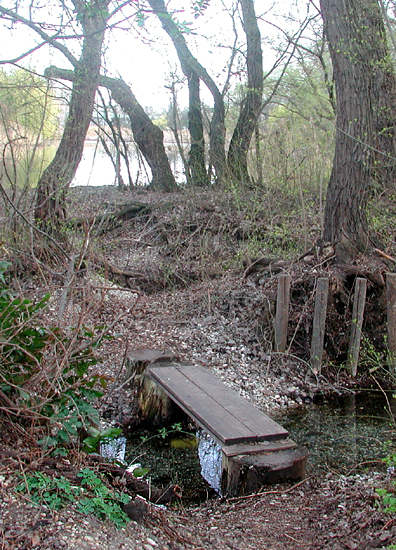Situated immediately below Gottweig Abbey, Furth and Palt are two villages that share a common railway station. Although unremarkable, two hoards of bronze torque’s, now on display in Museum Krems, not only provide evidence of the Danube’s meandering’s in 1,600 BC but also of religious practices and beliefs.
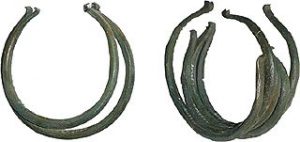
During the Bronze Age, torque’s of gold were worn as neck-pieces while those of bronze served as ingots and were used as currency. Here it is important to stress that transactions were not only conducted between people but also between people and gods and that the overwhelming majority of torque’s found have been found as hoards that were intended for the gods. This follows from the fact that most hoards were deposited in wet places such as moors, marshes and bogs where recovery was neither feasible nor intended and follows on from the Neolithic tradition according to which wet places were seen as portals that lead from one realm to another. During the Neolithic stone axes, associated with felling trees and building houses, were deposited in wet places and with the introduction of metal this was continued, with copper and bronze axes being deposited. Bronze objects of varying description were also thrown into rivers and sacred springs, with objects such as swords were broken so as to make them useless. The largest hoard of torque’s ever found consists of over six hundred neck-pieces. The patins’s of the torques found at Furt and Palt are mainly green, indicative of oxidation under dry conditions, yet there are also patches of brown and gold, indicative of a patina built up underwater. This fits in with the scenario of the artifacts being cast into a boggy environment and then found much later long after the land had been drained.
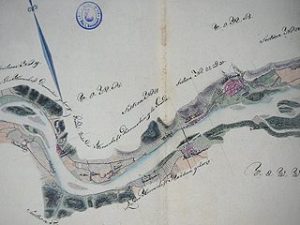
That Furt and Palt were once boggy swamps can be deduced not only from a study of old maps but also from their names. Like the word „ford“ to which it is related, „Furth“ is an Indo-Germanic word that refers to a shallow patch of water which can be forded. „Palt“ meanwhile derives from „balta“ which is a Slavic word that denotes a bog or swamp but which can also refer to mud, a lake, a pond or a boggy wood. When the distribution of such hoards is plotted on a map of Europe, the impression is that such offerings were made constantly. Yet when the length of time over which the Bronze Age extended is considered, the rate of depositions turns out to be less than two a year over the whole continent. This means that the making of an offering was an unusual event which was only experienced occasionally during the course of a person’s lifetime. In this connection it is of relevance to note that in Indo-Germanic languages, the word „palt“ is formally related to words which denote that which is „white“. While at first sight there is no connection between an area of wet-land and something that is white, when a „palt“ is seen as a portal to another world, the connection to white becomes apparent, for going through the portal of death results in white bones being left behind. This suggests that the offerings made at Furth and Palt were addressed to the gods and were made so as to establish and maintain a principle of „I give – you give“. Although it can be assumed that the entire population of a community will have been present when an offering was made, the pertinent question is, „Who officiated and in what name and in what capacity?“
The story of how this came about begins in the Ukraine, where, following the end of the Ice Age, water was plentiful. Then, sometime during the seventh millennium, a dry period set in and the steppes as known today came into being. Where the northern people of the region continued a semi-nomadic life-style of hunting and trapping, those in the South turned to livestock and became semi-nomadic herds-people. It was here that, in around 7,000 BC, that the process of the domestication of the horse began and from around 5.000 BC onwards, there is evidence of horse-drawn wagons being used in the Ukraine. Mainly breeding sheep, a people known as the Yamnaya found that the horse was an ideal means for herding large numbers of sheep over the steppes so that the horse was endowed with a symbolism that reflected its importance and meaning in their lives. Due the large numbers of animals kept, the lives of herds-people are sensitive to climatic changes, with times of plenty, hard winters and dry periods all leading to wild fluctuations. On three different occasions, different factors prompted the Yamnaya to look for fresh pastures and occupy new territories. The first wave of migration was between 4,600 and 4,300 BC with the Yamnaya being forced to move out both eastwards and westwards. In around 3,500 BC, from the western areas already colonised, a second wave advanced both North and South. Then some five hundred years later, between 3,100 and 2,900 BC, a drought caused the people in the northern regions either to continue moving North or to move South-West. Mounted on horses and armed with bronze weapons that were explicitly designed for killing people, where ever they went, the Yamnaya assumed the role of a conquering elite and subjugated local populations. This is shown by the daggers and axes that between 4,500 and 4,300 BC, suddenly become a characteristic of grave goods and stands in marked contrast to the Old European graves, where grave goods, although they included weapons for hunting, did not include weapons for use against people. Daggers with bronze blades and wooden handles were also made, along with axe-like hacks which consisted of a dagger blade mounted on a longer shaft that was bent at the point where the blade was affixed and an example of such a blade can be seen in Museum Krems.
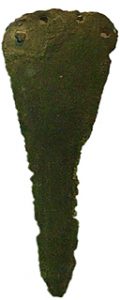
In addition the Yamnaya were armed with spears, short pikes and bows and arrows. Providing further evidence that prior to the Yamnayian take-over, Old Europe were largely peaceful, is the fact that Old European settlements were unprotected by defensive walls.
Combining archaeology, linguistics and human genealogy into a single narrative, genetic research confirms the picture of Old Europe as a matriarchal society of peaceful, arable farmers whose lives were suddenly interrupted by the arrival of aggressive, male orientated Yamnayians. The „Yamnaya“ are thus what linguists call the „Indo-Europeans“ and the nature of the take-over was such the Yamnaya are the primary ancestors of all northern Europeans today. Implementing a strategy that reoccurs throughout history, the new arrivals did not eradicate the old religion but instead subverted it, adding new elements and shifting emphases so as to bring it into line with their own world view. In accordance with the idea of Indo-Europeans being patriarchal, with considerable power being concentrated among a male elite, genetic research sees Yamnaya males as being extraordinarily successful in spreading their genes. This suggests that, unlike the Old Europeans, the Yamnaya understood that fatherhood was about passing the passing on of genetic information in the form of seed and was not something that like the rain, aided and abetted fertility in a purely general way.
Running parallel with this narrative, ceremonial artefacts suggest that the Yamnaya introduced themselves as missives from the sky who were appointed to rule on Earth by the sky-god who ruled the heavens. To this effect, on ceremonial occasions they would wear ornate, pointed hats made of beaten gold and introduced the scepter as a symbol of power. When they died and returned to their real homes in the sky, chambered graves were built for them, over which mounds of earth were then raised. Known in Tartar as „Kurgans“, as the migrations proceeded, so this burial practice can be geographically followed across Europe, leading to them being known as „The Kurgan Migrations“. Despite their impressive regalia and king-like status, Bronze Age rulers were really chieftains who ruled over small areas, with kingdoms that extended over larger areas and which were run by administrations that could field armies, only came into being during the later Iron Age. In mythology, unable to ignore that which has gone before, new mythologies up-date older narratives so as to cast the older ages and all they stood for in a negative light. Thus, reflecting the small size of the domains ruled over by Bronze Age chieftains, the gnomes of Germanic mythology, with their pointed hats, their lack of female spouses and their interest in yellow metals are in fact caricatures of Bronze Age rulers, with the Kurgans in which they were buried, being the mountains in which gnomes supposedly live. This makes two Bronze Age figures found at Stockhult in Sweden, the ancestors of all garden gnomes.
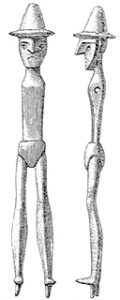
Sources
Bergmayer, A., Glossar der Etyma der eingedeutschten Namen slawischen Herkunft in Niederösterreich, Verlag der Österreichischen Akademie der Wissenschaften, Wien, 2005
Curtis, A., Decoding European Mythology: Why Gnommes lives in Mountains and wear pointed Hats, forthcoming
Fontijn, D. R., Sacrificial Landscapes, in Analecta praehistorica leidensa 33/34, University of Leiden, Faculty of Archaeology, 2002
Gimbutas, M., The Goddesses and Gods of Old Europe: 7,000-3,500 BC, Myths, Legends and Cult Images, University of California Press, Berkeley/Los Angeles, 1974
Gimbutas, M., The Civilisation of the Goddess: The World of Old Europe, Harper Collins Publishers Inc., London, 1991
Gimbutas, M., Das Ende Alteuropas, der Einfall von Steppennomaden aus Sudrussland und die Indogermanisierung Mitteleuropas, Archaeolingua Series Minor, Innsbrucker Beiträge zur Kulturwissenschaft, Innsbruck, 1994
Grossmann, U., Gold und Kult der Bronzezeit, Verlag des Germanisches Museum, Nurnberg, 2003
Haarmann, H., Die Indoeuropäer, Herkunft, Sprachen, Kulturen, Verlag C. H. Beck, Munich, 2010/2012
Meller, H. (editor), Der geschmiedete Himmel. Die weite Welt im Herzen Europas vor 3.600 Jahren, Wissentschaftliche Buchgesellschaft, Darmstadt, 2004
Reich, D., Who we are and how we got here, Oxford University Press, 2018


